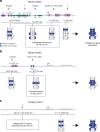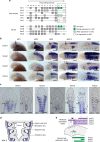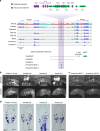A Hox-TALE regulatory circuit for neural crest patterning is conserved across vertebrates
- PMID: 30867425
- PMCID: PMC6416258
- DOI: 10.1038/s41467-019-09197-8
A Hox-TALE regulatory circuit for neural crest patterning is conserved across vertebrates
Abstract
In jawed vertebrates (gnathostomes), Hox genes play an important role in patterning head and jaw formation, but mechanisms coupling Hox genes to neural crest (NC) are unknown. Here we use cross-species regulatory comparisons between gnathostomes and lamprey, a jawless extant vertebrate, to investigate conserved ancestral mechanisms regulating Hox2 genes in NC. Gnathostome Hoxa2 and Hoxb2 NC enhancers mediate equivalent NC expression in lamprey and gnathostomes, revealing ancient conservation of Hox upstream regulatory components in NC. In characterizing a lamprey hoxα2 NC/hindbrain enhancer, we identify essential Meis, Pbx, and Hox binding sites that are functionally conserved within Hoxa2/Hoxb2 NC enhancers. This suggests that the lamprey hoxα2 enhancer retains ancestral activity and that Hoxa2/Hoxb2 NC enhancers are ancient paralogues, which diverged in hindbrain and NC activities. This identifies an ancestral mechanism for Hox2 NC regulation involving a Hox-TALE regulatory circuit, potentiated by inputs from Meis and Pbx proteins and Hox auto-/cross-regulatory interactions.
Conflict of interest statement
The authors declare no competing interests.
Figures








Similar articles
-
An atlas of anterior hox gene expression in the embryonic sea lamprey head: Hox-code evolution in vertebrates.Dev Biol. 2019 Sep 1;453(1):19-33. doi: 10.1016/j.ydbio.2019.05.001. Epub 2019 May 6. Dev Biol. 2019. PMID: 31071313 Free PMC article.
-
Analysis of lamprey meis genes reveals that conserved inputs from Hox, Meis and Pbx proteins control their expression in the hindbrain and neural tube.Dev Biol. 2021 Nov;479:61-76. doi: 10.1016/j.ydbio.2021.07.014. Epub 2021 Jul 24. Dev Biol. 2021. PMID: 34310923
-
A Hox regulatory network of hindbrain segmentation is conserved to the base of vertebrates.Nature. 2014 Oct 23;514(7523):490-3. doi: 10.1038/nature13723. Epub 2014 Sep 14. Nature. 2014. PMID: 25219855 Free PMC article.
-
Conservation and diversity in the cis-regulatory networks that integrate information controlling expression of Hoxa2 in hindbrain and cranial neural crest cells in vertebrates.Dev Biol. 2002 Jun 1;246(1):45-56. doi: 10.1006/dbio.2002.0665. Dev Biol. 2002. PMID: 12027433 Review.
-
Coupling the roles of Hox genes to regulatory networks patterning cranial neural crest.Dev Biol. 2018 Dec 1;444 Suppl 1:S67-S78. doi: 10.1016/j.ydbio.2018.03.016. Epub 2018 Mar 20. Dev Biol. 2018. PMID: 29571614 Review.
Cited by
-
An atlas of anterior hox gene expression in the embryonic sea lamprey head: Hox-code evolution in vertebrates.Dev Biol. 2019 Sep 1;453(1):19-33. doi: 10.1016/j.ydbio.2019.05.001. Epub 2019 May 6. Dev Biol. 2019. PMID: 31071313 Free PMC article.
-
The Mandibular and Hyoid Arches-From Molecular Patterning to Shaping Bone and Cartilage.Int J Mol Sci. 2021 Jul 14;22(14):7529. doi: 10.3390/ijms22147529. Int J Mol Sci. 2021. PMID: 34299147 Free PMC article. Review.
-
A genome-wide assessment of the ancestral neural crest gene regulatory network.Nat Commun. 2019 Oct 16;10(1):4689. doi: 10.1038/s41467-019-12687-4. Nat Commun. 2019. PMID: 31619682 Free PMC article.
-
Adaptive introgression reveals the genetic basis of a sexually selected syndrome in wall lizards.Sci Adv. 2024 Apr 5;10(14):eadk9315. doi: 10.1126/sciadv.adk9315. Epub 2024 Apr 3. Sci Adv. 2024. PMID: 38569035 Free PMC article.
-
Programmed DNA Elimination in Vertebrates.Annu Rev Anim Biosci. 2021 Feb 16;9:173-201. doi: 10.1146/annurev-animal-061220-023220. Epub 2020 Sep 28. Annu Rev Anim Biosci. 2021. PMID: 32986476 Free PMC article. Review.
References
-
- Le Douarin, N. & Kalcheim, C. The Neural Crest 2nd edn (Cambridge University Press, Cambridge, 1999).
-
- Parker, H. J., Pushel, I. & Krumlauf, R. Coupling the roles of Hox genes to regulatory networks patterning cranial neural crest. Dev. Biol.10.1016/j.ydbio.2018.1003.1016 (2018). - PubMed
-
- Gavalas A, Trainor P, Ariza-McNaughton L, Krumlauf R. Synergy between Hoxa1 and Hoxb1: the relationship between arch patterning and the generation of cranial neural crest. Development. 2001;128:3017–3027. - PubMed
Publication types
MeSH terms
Substances
LinkOut - more resources
Full Text Sources
Molecular Biology Databases

